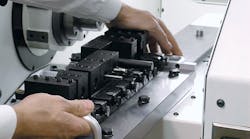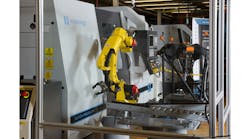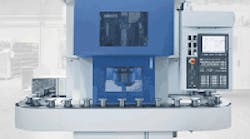Manufacturing medical parts remains a growth opportunity for machining operations, in part because demand for prosthetic devices continues to be strong thanks to a large population of aging citizens who aim to remain active and independent. Hardinge Inc. notes that there is a strong demand for high-precision components needed for neurological, orthopedic, spinal/bone fixation, dental implants, drug infusion, catheter connectors, optical, maxillofacial, micro/minimally invasive, surgical instruments, and other medical devices — most of which can be manufactured on Hardinge’s Quest® Super-Precision® GT27 gang-tool turning center.
The GT27 is designed to machine small diameters, complex and tight-tolerance parts, and other demanding specifications of precision parts. It achieves a continuous machining accuracy of 0.0002 in. on diameter, part roundness variation of 0.000015 in., and part-surface finish of 8 micro-inches: it has proven “indispensible to some of the best medical manufacturing companies in the world,” according to Hardinge.
For bar turning, stock up to 1.625 in./27 mm and chucked parts up to 4 in. in diameter (using a step chuck) can be machined on the GT27. The developer emphasized that level of accuracy can be expected to be maintained over a long term, “ten years down the road,” it projected.
Hardinge claimed the GT27 differs from other “gang tool” machines in that it includes a patented, interchangeable top plate and their quick-change, collet-ready spindle. The top plate secures to the dovetailed cross slide and is interchangeable for quick and accurate tooling changes that can be performed in under a minute. Pre-tooled top plates can be quickly interchanged within 0.0002 in. repeatability to produce a new part or family of parts.
Maximum rigidity, gripping
Hardinge’s patented collet-ready spindle delivers maximum rigidity and gripping power because the collet seats directly in the spindle, with minimal overhang from the spindle bearings. In this design the spindle accuracy is transferred directly to the workpiece.
Additionally, Hardinge noted its patented Harcrete® machine base is 10% stiffer than cast iron, which improves the structure’s dynamic stability with one-third less vibration at the spindle. It also increases tooling life by up to 30%. These factors improve machined parts’ surface finishes significantly more than cast iron structures.
The developer also emphasizes its lathes’ performance for “size repeatability, surface finish quality, and thermal stability.”
Hardinge proposes the GT27 for use as a stand-alone unit, a higher-capacity system with a bar feed, or as a fully automated system with a robot. It called the new machine “an excellent complement to a Swiss machine shop,” where it can handle jobs for parts that require higher precision. “Bar whip or chatter that may be found to some degree in Swiss turning, is not an issue with the GT27 because the bar or chucked part is gripped close to the spindle bearings,” it said.








